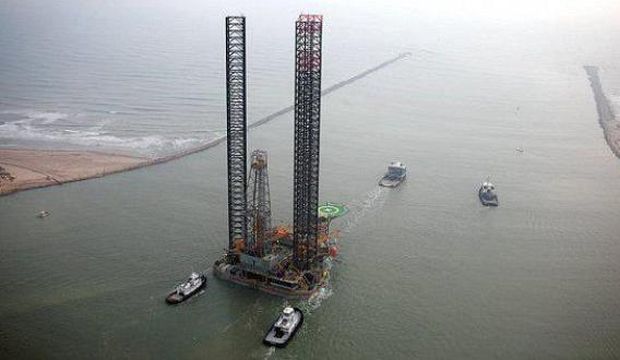www.aljazeerah.info
Opinion Editorials, February 2020
Archives
Mission & Name
Conflict Terminology
Editorials
Gaza Holocaust
Gulf War
Isdood
Islam
News
News Photos
Opinion Editorials
US Foreign Policy (Dr. El-Najjar's Articles)
www.aljazeerah.info
The Real Reason The Saudis Are Desperate To Restart The Giant Khafji Oilfield By Simon Watkins Oil Price, February 12, 2020 |
 |
 |
|
| Saudi-Kuwaiti Khafji oilfield 2014 asharq |
Sources from Kuwait and Saudi Arabia last week let it be known that trial production of 10,000 barrels per day (bpd) would start at the Khafji oil field in the ‘Partitioned Neutral Zone’ (PNZ) that it shares with Kuwait on or around the 25th of February, with the field likely to be pumping about 60,000 bpd by August. Trial production of 10,000 bpd will also begin in the Kuwaiti area of the Zone in late March, likely increasing to around 80,000 bpd by the end of September, according to the sources. The plan is that within 12 months Khafji will be producing around 175,000 bpd and Wafra about 145,000 bpd.
This said, it is an absolute truism that Saudi Arabia desperately needs the Brent crude oil benchmark price above US$84 per barrel - at the absolute minimum – to ensure that it does not record yet another dismal budget deficit this year. So, it is an absolute truism as well that the last thing a country should do when it desperately needs a higher oil price is to actually increase oil production, especially at a time when the outlook in the key demand element of the supply/demand equation – China – looks uncertain, given the current coronavirus scare. So, what is really going on here?
Such deficits have been running ever since the beginning of the Saudis’ strategically incompetent ‘plan’ begun in 2014 to destroy the then-nascent U.S. shale industry. Having not done the necessary homework in the first place – including an analysis of how the U.S. shale sector might react (i.e. as it transpired, by becoming leaner, meaner, and more cost efficient very quickly) – the Saudis succeeded in only nearly bankrupting itself and its OPEC supporters.
Having only finally twigged onto the appalling naïveté of its plan in 2016, Saudi has subsequently been chasing its own tail financially. It was forced to spend over US$250 billion of its own foreign exchange reserves to prop up its economy that even senior Saudis say have been lost forever.
So bad was the situation that in October 2016 the country’s deputy economic minister, Mohamed Al Tuwaijri, said that: “If we [Saudi Arabia] don’t take any reform measures, and if the global economy stays the same, then we’re doomed to bankruptcy in three to four years.” As it stands, having recorded budget deficits for the last few years, the estimates are that Saudi will continue to do so until at least 2025, so Saudi wanting to add to the vast level of oil supplies sloshing around the markets – with the hugely negative implications for price that this means – makes no sense, if all other factors have remained equal.
Okay, but maybe the Saudis are really just a bunch of friendly guys who care about helping out their neighbours, like plucky Kuwait? Leaving aside for one moment the fact that the Saudi ‘plan’ to take on the U.S. shale industry took its toll on Kuwait’s economy as well, the degree of petty spite and bullying that prompted the Saudis to close down the Neutral Zone in the first place in 2014 should not be underestimated or forgotten.
The official Saudi line at the time for the closure of Khafji was that it was not compliant with new environmental air emission standards issued by Saudi Arabia’s Presidency of Meteorology and Environment Authority (no, honestly, that was it).
Supposedly, the field – in addition to producing around 280,000-300,000 barrels per day (bpd) of Arabian Heavy grade crude oil just before its closure - also produced around 125 million standard cubic feet per day (mscfd) of associated gases and 50 mscfd of gas and a gas leak had sprung in one of its 15 platforms. Ergo, apparently, the entire area required shutting down, as supposedly the associated plant gathers its gas from all onshore facilities in the PNZ.
The unofficial version was that shutting the field down was Saudi Arabia’s way of ‘jerking Kuwait’s chain to keep it in line’, as the Kingdom perceived that its neighbour had been stepping on its toes in the months leading up to the closure. In this context, Kuwait had increased its overt competition to Saudi Arabia in the key Asian export markets to the point that it was selling oil to buyers in Asia at the widest discount to the comparable Saudi grade for 10 years.
Additionally, Kuwait had also been placing obstacles to the Kingdom’s own operations in the Wafra region of the PNZ by increasing the difficulty for Saudi Arabian Chevron (SAC) in obtaining work permits to operate in the Zone, jeopardising SAC’s ability to move ahead with its full-field steam injection project in Wafra that was intended to boost output of heavy oil there by more than 80,000 bpd.
The effect of the closure in 2014 was much more damaging to Kuwait than to Saudi, with the loss of Kuwait’s 50 per cent share of output effectively wiping out its spare capacity in one fell swoop, according to oil analysts at the time. Additionally, the closure made it all the more difficult for Kuwait to achieve its ambitious output expansion plans.
Given this, it is unsurprising to find that an accommodation on pricing to Asian export markets was worked through between the two sides, along with the situation regarding SAC’s visas, in preparation for the restarting of production at the field as soon as possible from the Kuwaiti side.
In a supreme twist of irony – and making nonsense of the current plan to re-open the PNZ – the key reason why the Khafji field was not allowed to be re-opened was the intervention of then-Deputy Crown Prince Mohammed bin Salman who did not want extra output coming into the markets, as this would have depressed the oil price even further than it had been already, according to oil analysts at the time. Saudi also wanted to maintain its leverage over Kuwait going forward, many analysts believed.
So, what is the possible explanation for suddenly allowing these long locked-down fields to go into production? It is, according to a range of sources spoken to by OilPrice.com since the 14 September attacks the fact that Saudi was not telling the truth about the extent of the damage then and it is not telling the truth now either.
As highlighted to OilPrice.com at the time of the attacks by global energy consultancy Energy Aspects’ senior energy analyst Richard Mallinson: “It was extremely telling that he [Abdulaziz bin Salman] spoke of ‘capacity’ and later of ‘supply to the market’, as these are terms that Saudi tends to use in order to avoid talking about actual production, as capacity and supply are not the same thing at all as actual production at the wellheads.” He added: “What Saudi is trying to do by not revealing the true picture is to protect its reputation as a reliable oil supplier, especially to its target clientele in Asia, so we have to take all of these comments with a hefty pinch of salt,” he added.
“Engineers we have spoken to have said that following an incident like this it would take several weeks just to assess the damage, never mind to begin doing anything about it, rather than the few days that the Saudis have taken and then announced the actual timeline – and a very short timeline at that – to bring back various stages of capacity,” he concluded.
***
Simon Watkins is a former senior FX trader and salesman, financial journalist, and best-selling author. He was Head of Forex Institutional Sales and Trading for Credit Lyonnais, and later Director of Forex at Bank of Montreal. He was then Head of Weekly Publications and Chief Writer for Business Monitor International, Head of Fuel Oil Products for Platts, and Global Managing Editor of Research for Renaissance Capital in Moscow.
***
Share the link of this article with your facebook friends
|
|
|
|
||
|
||||||


